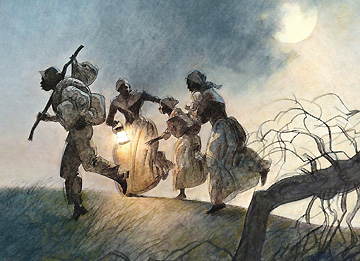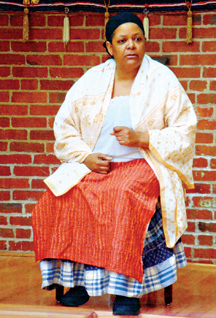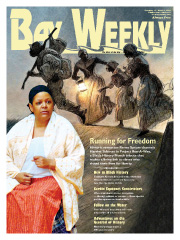Running for Freedom

Project Run-A-Way makes a living link to slaves who risked their lives for liberty
by Marilyn Recknor
Imagine the last few pages of Bay Weekly filled with notices placed by slave owners for the return of runaways. You might see an ad like one in a 1797 colonial newspaper by an owner trying to find “a negro man named JEM, a lively, brite, active fellow when he pleases ...”
Readers of the 1810 Maryland Republican and the Maryland Gazette (at 280 years old, part of The Capital newspaper family) would have paid attention to such ads and looked out for escaped slaves the same way people of 2010 view America’s Most Wanted and watch for criminals.

 Runaway ads were so common in the late 18th and early 19th centuries in Mid-Atlantic and Southern states that they developed stylistic conventions. Readers learned the slave’s name, and method of escape. JEM, for example, “left under a pretence of going to take care of my house in Annapolis.” A description gave specifics of age, skin color, height and other physical features such as scars or a short leg. Clothing was also detailed: JEM “took with him a Wig, a new Felt Hat, a grey Pea Jacket, red Waistcoat and Breeches.” As were personal habits: JEM “has great hesitation in his speech when he laughs, chews his gums”; and talents: “something of a gardiner, carpenter, and bricklayer.”
Runaway ads were so common in the late 18th and early 19th centuries in Mid-Atlantic and Southern states that they developed stylistic conventions. Readers learned the slave’s name, and method of escape. JEM, for example, “left under a pretence of going to take care of my house in Annapolis.” A description gave specifics of age, skin color, height and other physical features such as scars or a short leg. Clothing was also detailed: JEM “took with him a Wig, a new Felt Hat, a grey Pea Jacket, red Waistcoat and Breeches.” As were personal habits: JEM “has great hesitation in his speech when he laughs, chews his gums”; and talents: “something of a gardiner, carpenter, and bricklayer.”
Runaway slave ads were businesslike, as owners cited payment in shillings, pounds, dollars or even country produce for their lost property.
They paid the price to describe at length because a slave was valuable property.
We know all this because two Annapolis historians convinced The Historic Annapolis Foundation to make runaway slaves its new project. Project Run-A-Way made its debut this month at the Second Annual Black History Month Seminar at the Wiley Bates Legacy Center.

Writer Janice Hayes-Williams, left, and actor Scotti Preston hunted through colonial newspapers to learn more about how slaves lived. From their research came Project Run-A-Way.
|
 Actor Scotti Preston of Historic Annapolis Foundation and writer Janice Hayes-Williams became fascinated as they hunted through colonial newspapers to learn more about the lives of slaves.
Actor Scotti Preston of Historic Annapolis Foundation and writer Janice Hayes-Williams became fascinated as they hunted through colonial newspapers to learn more about the lives of slaves.
The detail, especially of the clothing runaways wore, gave them a bright idea. “We are shamelessly using the term Project Run-A-Way, from Project Runway, the popular Lifetime Network television show about designers competing to show their creations at Fashion Week in New York,” Preston told the audience at this year’s snow-delayed Black History Seminar at Bates Center, Annapolis’ original black high school.
Preston and Hayes-Williams envisioned reenactors walking a runway in the clothes described in old newspaper advertisements. From that jumping off point, the reenactors would work their way into the hearts and times of the people who escaped servitude to seek freedom, reading between the lines of the ads and drawing from other documents of the period to create living portraits.
“You have to get out of your own way,” Preston said, to let your character come through. She forms a whole character by studying ads and other records. For instance, looking at an ad that offers an exorbitant reward of $50 or $65, Preston concludes that the runaway meant a great deal to the owner.
“Land plus tobacco plus labor was the key to success” in Chesapeake country, the Foundation’s Jean Russo told the black history audience. In addition to African slaves, Maryland colonists made use of other forms of bound labor, importing apprentices in the trades and indentured servants, who served four to seven years to pay for their passage to the colonies. Convicts banished from England added to the labor pool.
All these people in servitude had reasons to escape from or resist their masters. Some wanted to reunite with family or friends. Some ran to avoid being sent to the Deep South. Some ran from abusive situations. Some wanted to renegotiate the terms of their bondage.
Slave reenactments, Preston said, honor “the triumph of a person who says I have had enough” and is ready to die for an alternative.
“This is the face of a runaway,” Hayes-Williams told the audience, directing attention to a photograph of orator and statesman Frederick Douglass. Born in Talbot County, Douglass was raised to be a companion slave with special privileges. After seeing the brutality other slaves endured and being sold to a cruel master and experiencing abuse himself, Douglass fled with a group of men. They were captured and jailed. His second attempt to run away was successful, and he became a prominent writer, speaker and public figure.
Historic reenactor Renee Spears channeled another runaway. Dressed as the famous escaped slave and underground railroad conductor Harriet Tubman, Spears clutched her shawl as she confided to the audience how the master sent her to catch muskrats and pick cotton. The room hushed as her voice fell to a whisper, conveying the fear Tubman must have felt hearing a railway policeman read a description of her and demanding, “Have you seen this woman?”

Historic reenactor Renee Spears channels another runaway: The famous escaped slave and underground railroad conductor Harriet Tubman.
|
 Running away was one among many forms of resistance to slavery, according to Laura Kamoie, history professor at the U.S. Naval Academy. Another form of resistance was rebellion, especially in the Caribbean and Brazil. These markets accounted for 85 percent of African slaves brought to the New World. Mostly men, they were destined for hard labor in sugar mills, which ran 24 hours a day. Brutal conditions and supplies of fresh replacements from Africa led to violent rebellions.
Running away was one among many forms of resistance to slavery, according to Laura Kamoie, history professor at the U.S. Naval Academy. Another form of resistance was rebellion, especially in the Caribbean and Brazil. These markets accounted for 85 percent of African slaves brought to the New World. Mostly men, they were destined for hard labor in sugar mills, which ran 24 hours a day. Brutal conditions and supplies of fresh replacements from Africa led to violent rebellions.
Thomas Jefferson called the American Revolution the biggest slave rebellion, based on his estimate that 30,000 slaves left servitude to join the British army.
America imported only 4.5 percent of stolen, enslaved Africans. These were less desirable slaves, including more women. Owners encouraged large families, making men less likely to resist because they had something to lose. The slaves most likely to run away were single and male, second- or third-generation slaves who could speak the language and who had a skill, such as carpentry, blacksmithing or sailmaking.
Enlisting midshipmen from Kamoie’s classes at the Naval Academy, Historic Annapolis Foundation continues cataloguing to create its database of runaway ads. Project Run-A-Way, covering the period from 1720 to emancipation, extends to educational partnerships, historical reenactments and a traveling exhibition. An Internet presence, including a blog, will chart the progress of the ongoing project.
“A multi-year project like this is a huge commitment, but it’s the type of thing Historic Annapolis Foundation should be doing, engaging and illuminating our community in history. So we really do want the community involved as volunteers,” said the Foundation’s Heather Ersts.
Meanwhile, the Maryland State Archives is working to discover and catalog slave experiences, mainly between 1830 and 1860.
A website, www.mdslavery.net, provides maps, case studies, electronic documents and an image gallery. On interactive maps, you can trace the path a runaway might have followed.
Preston envisions a stage filled with men and women standing on platforms. The lights dim and a spotlight shines on a reenactor, who tells the story of one individual, “who had the wherewithal to make the best of conditions … who had a spiritual connection with something greater.”
Preston says, “With living history the impact lives longer. Think of it as the sound bite that sticks with you, the one that reminds you” of slaves who were “artful, cunning and clever.”
![]()





